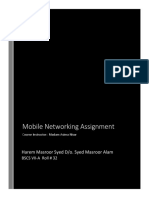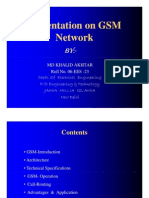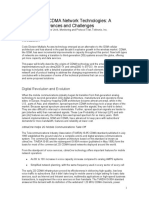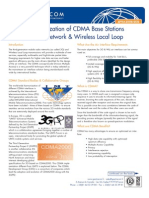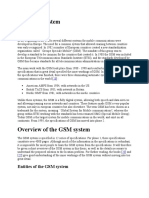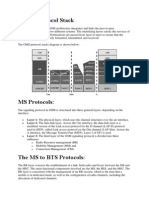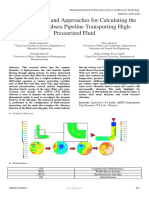Module 2 Notes
Uploaded by
rohithrk594Module 2 Notes
Uploaded by
rohithrk594lOMoARcPSD|37107235
Module-2 Notes
Electronic and communication (Visvesvaraya Technological University)
Scan to open on Studocu
Studocu is not sponsored or endorsed by any college or university
Downloaded by Rohith J.E (rohithrk594@gmail.com)
lOMoARcPSD|37107235
Wireless and Cellular Communication 18EC81
MODULE-2 (GSM and TDMA Technologies)
Introduction to GSM and TDMA
GSM services
• Teleservices – provide standard voice communication between two end users and
additional communications between two end user applications according to some
standard protocol.
• Bearer services- provide the user the ability to transmit data between user network
interfaces.
GSM frequency bands and channel numbers.
Introduction to GSM and TDMA
GSM timeslots
For a particular carrier frequency, a channel consists of a single timeslot that occurs during a
TDMA frame of eight timeslots. Each of these timeslots represents a physical channel.
Downloaded by Rohith J.E (rohithrk594@gmail.com)
lOMoARcPSD|37107235
Wireless and Cellular Communication 18EC81
GSM Network and System Architecture
Mobile station – Provides link between the GSM subscriber and the wireless mobile network.
GSM system makes use of SIM card that when inserted into the M.S makes it functional.
Base station system – It is the link between the MS and the GSM mobile services switching
centre. It consists of two elements
• A base transceiver system
• A Base station controller
Network switching system – Provides the necessary interface for the connection of the
wireless network to another network.
The switching system maintains the databases that are used to store information about the
subscriber to facilitate the connection.
• SMS gateway – To handle short message service
• Flexible numbering register – It is used by the GSM system to provide number
portability to the subscriber
Operation and support system and other nodes – Provide surveillance of the complete
network and thus provide the operator a means to support operation and maintenance of
the entire network.
Downloaded by Rohith J.E (rohithrk594@gmail.com)
lOMoARcPSD|37107235
Wireless and Cellular Communication 18EC81
GSM network interfaces and protocols
GSM interfaces
• Um interface
• Abis interface –It exists between the BSC and the BTS
• A interface - It exists between the BSC and the MSC
• Ater interface – Only exists in GSM systems that have separate units for the transcoder
controller and BSC
Downloaded by Rohith J.E (rohithrk594@gmail.com)
lOMoARcPSD|37107235
Wireless and Cellular Communication 18EC81
GSM Channel Concept
The GSM cellular system is based on the use of Time division multiple access to provide
additional user capacity over a limited amount of radio frequency spectrum.
Frames – GSM system divides the radio link connection time into eight equal and repeating
timeslots known as frames.
Multiframes – The system can use several different types of repeating frame structures
known as multiframes.
Logical channels
• Broadcast channels – Provides information to the MS about various system
parameters and information about the location area identity (LAI). Three types of
broadcast channels
Broadcast control channel – Contains information that is needed by the MS
concerning the cell that is attached to for the MS to be able to start making or receiving
call
Frequency correction channel - Transmits bursts of zeros to the MS
Synchronization channel – It is used to transmit the required information for the MS
to synchronize itself within the timing within a particular cell
• Common control channels – Provides paging messages to the MS and a means by
which the mobile can request a signalling channel that it can use to contact a network
Paging channel – It is used by the system to send paging messages to the mobiles
attached to the cell
Random access channel – Used by the mobile to respond to a paging message
Downloaded by Rohith J.E (rohithrk594@gmail.com)
lOMoARcPSD|37107235
Wireless and Cellular Communication 18EC81
Access grant channel – Used by the network to assign a signalling channel to the MS
Stand-alone dedicated control channel
Slow associated control channel – Used to transmit information about measurements
made by the MS
Fast associated control channel – Used to facilitate the handover operation in a GSM
system
Cell broadcast channel – Used to deliver short message service.
Speech processing
In mobile, speech is digitized and broken up into 20-ms segments. It is then coded to reduce
the bit rate and control errors.
The receiver works as follows- Signal bursts are received and used to create a channel model.
These modules are speech coding, channel coding, interleaving, ciphering, burst assembly,
modulation. Speech coding block uses 13kbps RELP (Residually Excited Linear Predictive
coder). Channel coding block uses convolution coding of rate 1/2 with constraint length of 5.
Interleaving block does diagonal interleaving, after 456 encoded bits in 20ms duration are
broken into 57 bits sub-blocks.
There will be about total 8 sub blocks of 57 bits each. Ciphering block uses A3 and A5
encryption algorithms. Encryption is changed call by call to enhance privacy. Burst assembly
block frames the burst as required by GSM frame structure. The same is modulated and
Gaussian filtered. Modulation block minimizes the occupied BW using GMSK modulation with
BT of 0.3.
Downloaded by Rohith J.E (rohithrk594@gmail.com)
lOMoARcPSD|37107235
Wireless and Cellular Communication 18EC81
GSM Channel Concept
Timeslots and TDMA frames
GSM system, both traffic and signalling and control information are transmitted over the
physical frequency channel. To accomplish this time division multiplexing is used.
TDMA frames
In GSM system 8 timeslots constitute a frame. The system assigns numbers to the frames
from 0 to 2,715,648 and then repeats, the grouping of successive TDMA frames is known as
Hyper frame. The hyper frame consists of 2,048 super frames and takes 3 hrs 28 mins 53secs
and 760msecs to complete. Each super frame consists of 1326 TDMA frames that takes
approximately 6.12secs to complete. These super frames may take on one of the two possible
formats.
Downloaded by Rohith J.E (rohithrk594@gmail.com)
lOMoARcPSD|37107235
Wireless and Cellular Communication 18EC81
Timeslots
The organization of the transmitted digital bits within air-interface itself can take on several
different formats depending upon the type of information being transmitted.
Mapping of logical channels to physical channels
• Multiplexing of GSM logical channels
• Different schemes
• Needed control signals
Downloaded by Rohith J.E (rohithrk594@gmail.com)
lOMoARcPSD|37107235
Wireless and Cellular Communication 18EC81
The system needs to be able to transmit both traffic and signalling and control information to
the subscriber. The subscriber needs to be able to access the system and request radio
resources to setup a call or to send data.
Transmission of short messages
Traffic channels
Timeslot 0 and another timeslot is used to by broadcast and control channels and the
dedicated control channels. The six timeslots are used as traffic channels.
Paging groups
The mobile will be assigned by the network to a particular paging group through an algorithm.
GSM Identities
Mobile station associated numbers
The MS has a mobile station ISDN number that uniquely identifies a mobile telephone. It is a
dialable number and is linked to one HLR.
The IMSI is a unique identity allocated to each subscriber by the wireless service operator and
stored in the subscribers SIM.
Downloaded by Rohith J.E (rohithrk594@gmail.com)
lOMoARcPSD|37107235
Wireless and Cellular Communication 18EC81
GSM System Operations (Traffic Cases)
Registration, call setup, and location updating
Call setup
Interrogation phase
For the interrogation phase the initial address message comes outside the GSM network.
Radio resource connection establishment
The MSC/VLR initiates the call setup process by sending a message to the appropriate BSC.
The BSC sends a paging command message to the appropriate BTS, finally BTS sends a paging
request to the appropriate MS.
Service request
The service request occurs as soon as the MS has tuned to the new channel assigned to it .
The BTS sends back the MS an UA frame that contains the original paging response message.
The paging response message is forwarded to the BSC.
Authentication
Authentication request message is sent to the MS. The message containing 128bit RAND
number, CKSN. The MS stores the CKSN and then calculates the value of signed response. The
value of SREs is returned to the MSC/VLR as an authentication response message.
Ciphering mode setting
The MSC/VLR sends cipher mode command to the BSC. This message contains the value of
Kc. This value is forwarded to the BTS. BTS stores this value
IMEI check
If the IMEI number is to be checked the MSC/VLR sends an identity request message to the
MS. This is sent to the BSC. The value of IMEI sent by the mobile is checked against the
equipment identity register database.
TMSI reallocation
If TMSI number is to be used it is sent to the MS from the MSC/VLR. The value of TMSI number
is stored in the SIM card and TMSI reallocation complete message is sent to the MSC/VLR
Downloaded by Rohith J.E (rohithrk594@gmail.com)
lOMoARcPSD|37107235
Wireless and Cellular Communication 18EC81
Call initiation procedure
Connection management message is sent from the BTS to the MS. The MS will send a call
confirmed message if it can handle the requested service.
Assignment of a traffic channel
Traffic channel assignment is initiated by the MSC. The MSC sends an assignment request
message to the BSC. If the assignment is done , then the BSC calculates the MS output power
level , selects an idle channel and sends an channel activation message to the BTS. At this
point MS tunes to the new channel
Call confirmation, call accepted, and call release
The call confirmation procedure starts when the MS sends an alerting message to the MSC.
When the alerting message is received the MSC/VLR sends the TUP address complete
message to the calling subscriber who can now hear the ringing tone generated in the MSC.
Location updating
Normal location updating (idle mode)
The basic steps are radio resource connection establishment, service request, authentication,
cipher mode setting and then radio resource connection release.
10
Downloaded by Rohith J.E (rohithrk594@gmail.com)
lOMoARcPSD|37107235
Wireless and Cellular Communication 18EC81
IMSI detach/attach location updating
When the MS is being turned off the mobile requests the SDCCH, the message sends the
message to the network that is about to enter the detached state. The MS denotes the MS
status in the VLR. The VLR will reject incoming calls for the MS sending a voice message back
to the caller that the subscriber is currently unavailable.
Periodic location updating
Periodic location updating is used to prevent unnecessary use of network resources such as
the paging of a detached MS.
Call handoff
Intra-BSC handover
In this case the handover is occurring between the cells that are connected to the same BSC.
11
Downloaded by Rohith J.E (rohithrk594@gmail.com)
lOMoARcPSD|37107235
Wireless and Cellular Communication 18EC81
Inter-BSC handover
In this case the mobile has moved to a cell that is in different location area and therefore has
different BSC.
The serving BSC decides that the call must be handed over to a new cell that belongs to
different BSC.
12
Downloaded by Rohith J.E (rohithrk594@gmail.com)
lOMoARcPSD|37107235
Wireless and Cellular Communication 18EC81
Inter-MSC handover
Another possible handover that can occur is when the BSC decides that a handover should
occur, and the new cell belongs to the new MSC.
13
Downloaded by Rohith J.E (rohithrk594@gmail.com)
lOMoARcPSD|37107235
Wireless and Cellular Communication 18EC81
14
Downloaded by Rohith J.E (rohithrk594@gmail.com)
lOMoARcPSD|37107235
Wireless and Cellular Communication 18EC81
GSM Infrastructure Communications (Um Interface)
Layer 3: Networking layer operations
GSM network layer provides the mobile network signalling service for mobile subscribers.
The MNS includes
• Connection management (CM)
CM sublayer contains functions for call control, call related supplementary services, non-call
related supplementary services.
Call control- these procedures are used during call establishment. Provides service using
MNCC-SAP
Short message service support- short message service entities known as short message
control use short message control protocol, (SM-CP)
Supplementary services – SS handles services that are not related to a specific call.
15
Downloaded by Rohith J.E (rohithrk594@gmail.com)
lOMoARcPSD|37107235
Wireless and Cellular Communication 18EC81
• Mobility management
MM sublayer performs 3 types of procedures that are related to mobility support,
subscriber confidentiality, and service of the CM entity.
• Radio resource management
The primary function of the RR procedure is to establish, maintain and when no longer
needed, release a dedicated connection between the MS and BTS.
Layer 2: Data Link layer operations
LAPD operations- LAPD is used on the GSM interface between the BSC and the BTS.
Supports two types of operation
• Unacknowledged
• Acknowledged
Service access points – These are the gateways through which services are offered to the
higher layers.
Data link layer procedure-
• Data link procedure
• Data link distribution procedure
16
Downloaded by Rohith J.E (rohithrk594@gmail.com)
lOMoARcPSD|37107235
Wireless and Cellular Communication 18EC81
• Random access procedure
Layer 1: Physical layer operations
Physical layer is the actual physical hardware, modulation schemes, channel coding. Physical
layer interfaces the data link layer
North American TDMA
NA- TDMA was developed as 2G cellular system. The first implementation did not support
packet data transfer.
The 3G version has added additional air interface standard.
17
Downloaded by Rohith J.E (rohithrk594@gmail.com)
lOMoARcPSD|37107235
Wireless and Cellular Communication 18EC81
QUESTIONS
1. Explain the GSM network and system architecture along with its interfaces and protocols.
2. Explain the GSM channel concept and TDMA frames.
3. Explain all the GSM system operation for traffic cases.
4. Explain the inter-BSC handover, intra BSC-handover and inter- MSC handover.
5. Explain the Um interface of GSM infrastructure communications.
18
Downloaded by Rohith J.E (rohithrk594@gmail.com)
You might also like
- Mobile Network Optimization: A Guide for 2G and 3G Mobile Network OptimizationFrom EverandMobile Network Optimization: A Guide for 2G and 3G Mobile Network Optimization3.5/5 (3)
- NOKIA BTS Questions and Answers Post Training Ver1No ratings yetNOKIA BTS Questions and Answers Post Training Ver110 pages
- Overview of The Global System For MobileNo ratings yetOverview of The Global System For Mobile16 pages
- Presented by Meenu Singh Supervised by Mr. Sunny Bhushan: Presentation On GSM NetworkNo ratings yetPresented by Meenu Singh Supervised by Mr. Sunny Bhushan: Presentation On GSM Network33 pages
- Unit 4 - Mobile Communication - WWW - Rgpvnotes.inNo ratings yetUnit 4 - Mobile Communication - WWW - Rgpvnotes.in9 pages
- Unit 4 - Mobile Communication - WWW - Rgpvnotes.inNo ratings yetUnit 4 - Mobile Communication - WWW - Rgpvnotes.in9 pages
- Wireless and Mobile Communication Slide Chapter 5No ratings yetWireless and Mobile Communication Slide Chapter 526 pages
- An Overview of Wireless Data CommunicationsNo ratings yetAn Overview of Wireless Data Communications63 pages
- Mobile Networking Assignment: Harem Masroor Syed D/o. Syed Masroor AlamNo ratings yetMobile Networking Assignment: Harem Masroor Syed D/o. Syed Masroor Alam34 pages
- CDMA-DSS I 01 200904 Principle of Telecommunication-37No ratings yetCDMA-DSS I 01 200904 Principle of Telecommunication-3737 pages
- GSM: System Architecture: Prepared by Mehrin MeherNo ratings yetGSM: System Architecture: Prepared by Mehrin Meher28 pages
- Lecture 7 2g Cellular Systems by Rab Nawaz JadoonNo ratings yetLecture 7 2g Cellular Systems by Rab Nawaz Jadoon21 pages
- White Paper: CDMA Network Technologies: A Decade of Advances and ChallengesNo ratings yetWhite Paper: CDMA Network Technologies: A Decade of Advances and Challenges11 pages
- Global System For Mobile Communication (GSM)No ratings yetGlobal System For Mobile Communication (GSM)65 pages
- A Mobile & Cellular Communication Assignment On: Opic No: 46No ratings yetA Mobile & Cellular Communication Assignment On: Opic No: 4616 pages
- MOBILINK - Trainnig Workshop For Optimization GSM BASICNo ratings yetMOBILINK - Trainnig Workshop For Optimization GSM BASIC89 pages
- Report On Six Month Industrial Training: "Planning and Implementation"No ratings yetReport On Six Month Industrial Training: "Planning and Implementation"21 pages
- M2M Communication Based Wireless SCADA For Real-Time Industrial AutomationNo ratings yetM2M Communication Based Wireless SCADA For Real-Time Industrial Automation3 pages
- GSM Theories, Network Analayzation & Microwave TransmissionNo ratings yetGSM Theories, Network Analayzation & Microwave Transmission57 pages
- 3G & 4G Standards: 1. Explain About Global System For Mobile (GSM)No ratings yet3G & 4G Standards: 1. Explain About Global System For Mobile (GSM)8 pages
- 1 - Introduction and Motivation: Evolving of Technology To 4G WirelessNo ratings yet1 - Introduction and Motivation: Evolving of Technology To 4G Wireless13 pages
- From GSM to LTE-Advanced Pro and 5G: An Introduction to Mobile Networks and Mobile BroadbandFrom EverandFrom GSM to LTE-Advanced Pro and 5G: An Introduction to Mobile Networks and Mobile BroadbandNo ratings yet
- Lesson 5 (PHILOSOPHIES OF BUSINESS PRACTICES)No ratings yetLesson 5 (PHILOSOPHIES OF BUSINESS PRACTICES)70 pages
- Peace Corps OST Focus In/Train Up (FITU) Focus in - Train Up Action PlanNo ratings yetPeace Corps OST Focus In/Train Up (FITU) Focus in - Train Up Action Plan2 pages
- National Association For Lay Ministry Code of EthicsNo ratings yetNational Association For Lay Ministry Code of Ethics2 pages
- GR 9 Final Assessment Datesheet and SyllabusNo ratings yetGR 9 Final Assessment Datesheet and Syllabus7 pages
- Express Limited Warranty: FORM 6315 First EditionNo ratings yetExpress Limited Warranty: FORM 6315 First Edition2 pages
- CFD Modeling and Approaches For Calculating The Losses of A Subsea Pipeline Transporting HighPressurized FluidNo ratings yetCFD Modeling and Approaches For Calculating The Losses of A Subsea Pipeline Transporting HighPressurized Fluid7 pages
- AWS Solutions Architect Associate Study PlanNo ratings yetAWS Solutions Architect Associate Study Plan5 pages
- [Ebooks PDF] download The Event Manager s Bible How to Plan and Deliver an Event 2nd Edition Des Conway full chapters100% (8)[Ebooks PDF] download The Event Manager s Bible How to Plan and Deliver an Event 2nd Edition Des Conway full chapters85 pages
- Sample Weber Health Assessment Nursing 7th100% (1)Sample Weber Health Assessment Nursing 7th30 pages
- Css Ro Details Modified Final-1310202343No ratings yetCss Ro Details Modified Final-13102023436 pages
- Mobile Network Optimization: A Guide for 2G and 3G Mobile Network OptimizationFrom EverandMobile Network Optimization: A Guide for 2G and 3G Mobile Network Optimization
- NOKIA BTS Questions and Answers Post Training Ver1NOKIA BTS Questions and Answers Post Training Ver1
- Presented by Meenu Singh Supervised by Mr. Sunny Bhushan: Presentation On GSM NetworkPresented by Meenu Singh Supervised by Mr. Sunny Bhushan: Presentation On GSM Network
- Unit 4 - Mobile Communication - WWW - Rgpvnotes.inUnit 4 - Mobile Communication - WWW - Rgpvnotes.in
- Unit 4 - Mobile Communication - WWW - Rgpvnotes.inUnit 4 - Mobile Communication - WWW - Rgpvnotes.in
- Mobile Networking Assignment: Harem Masroor Syed D/o. Syed Masroor AlamMobile Networking Assignment: Harem Masroor Syed D/o. Syed Masroor Alam
- CDMA-DSS I 01 200904 Principle of Telecommunication-37CDMA-DSS I 01 200904 Principle of Telecommunication-37
- GSM: System Architecture: Prepared by Mehrin MeherGSM: System Architecture: Prepared by Mehrin Meher
- White Paper: CDMA Network Technologies: A Decade of Advances and ChallengesWhite Paper: CDMA Network Technologies: A Decade of Advances and Challenges
- A Mobile & Cellular Communication Assignment On: Opic No: 46A Mobile & Cellular Communication Assignment On: Opic No: 46
- MOBILINK - Trainnig Workshop For Optimization GSM BASICMOBILINK - Trainnig Workshop For Optimization GSM BASIC
- Report On Six Month Industrial Training: "Planning and Implementation"Report On Six Month Industrial Training: "Planning and Implementation"
- M2M Communication Based Wireless SCADA For Real-Time Industrial AutomationM2M Communication Based Wireless SCADA For Real-Time Industrial Automation
- GSM Theories, Network Analayzation & Microwave TransmissionGSM Theories, Network Analayzation & Microwave Transmission
- 3G & 4G Standards: 1. Explain About Global System For Mobile (GSM)3G & 4G Standards: 1. Explain About Global System For Mobile (GSM)
- 1 - Introduction and Motivation: Evolving of Technology To 4G Wireless1 - Introduction and Motivation: Evolving of Technology To 4G Wireless
- From GSM to LTE-Advanced Pro and 5G: An Introduction to Mobile Networks and Mobile BroadbandFrom EverandFrom GSM to LTE-Advanced Pro and 5G: An Introduction to Mobile Networks and Mobile Broadband
- Peace Corps OST Focus In/Train Up (FITU) Focus in - Train Up Action PlanPeace Corps OST Focus In/Train Up (FITU) Focus in - Train Up Action Plan
- National Association For Lay Ministry Code of EthicsNational Association For Lay Ministry Code of Ethics
- CFD Modeling and Approaches For Calculating The Losses of A Subsea Pipeline Transporting HighPressurized FluidCFD Modeling and Approaches For Calculating The Losses of A Subsea Pipeline Transporting HighPressurized Fluid
- [Ebooks PDF] download The Event Manager s Bible How to Plan and Deliver an Event 2nd Edition Des Conway full chapters[Ebooks PDF] download The Event Manager s Bible How to Plan and Deliver an Event 2nd Edition Des Conway full chapters


















